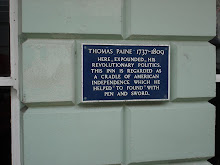
Wandering around Lewes in the early evening I looked again at a building with which I was once very familiar. WE Baxter Ltd, printers and bookbinders, a company with its roots right back in the early nineteenth century. Its founder George Baxter was a pioneer in the craft of colour printing and the prints he made are now highly collectable. Utilising a laborious method of separate engravings for each oil-based hue, the image was built up with many layers of individual colours all needing to 'register' perfectly one upon the other. None of your 4 colour process or CMYK here, then. Enormous numbers of these prints were produced, some estimates exceeding 100,000 which is nothing short of remarkable when you consider the primitive hand production methods. I worked at Baxters back in the early nineteen seventies and even then it was a business somewhat lagging behind the times. Theirs was a letterpress shop rather than having adopted the soon-to-be-universal photo-lithography. A world of hot metal type individually cast at great speed by Monotype casting machines. There was the clatter of the compressed air keyboards with anything up to a dozen men tapping away on what looked like vast typewriters producing spools of perforated paper making up the coded copy which, when fed into the casting machines on the floor below told them which fonts, upper or lower case letters, punctuation marks and numerals to use. If the keyboard room was loud, then the casting room below was like Dantes Inferno - everyone who worked there was practically deaf and wore no ear protection. The stifling heat radiated by the individual cauldrons of molten type (hot) metal was almost unbearable. Great shiny ingots of lead alloy embossed with the name 'Fry' were automatically lowered into the melting pots to replenish the quantities required to make all the letters needed to set a book, or a magazine or any of the printed ephemera we produced. The caster operators selected the correct Monotype matrices for whichever font was specified and the machine cast the words letter by letter in a continuing stream of fresh, hot type. The trays of type would then be rushed to the composing room where the overseer would select which compositor would be suitable for a particular task. Everything now was made up into paragraphs, have illustrative blocks added and the whole locked up in a 'chase'. Laid on a proofing press, the virginity of the type was deflowered by the application of a roller full of black ink. The resulting 'pull' usually on newsprint was then looked at by the compositor who rectified any defective characters, rising spaces or obvious spelling errors before passing a fair copy to 'the readers'. If all else was racket and mayhem, then the proof readers room was perfect quietude. Here, ancient men sat in Dickensian splendour on high stools with writing slopes before them. It was their job to read and correct all copy set by the company. Referring to original manuscripts or text supplied by customers they were tasked with reading every word and numeral to check for spelling, punctuation, style and even sense. They used hard blue long-leaded pencils to make their marks and when their work was complete, the copy was returned to the 'comp room' for correction. Then the whole process was gone through again. Finally, passed for press, the chase with its locked up type went into the machine room and was delivered to a machine minder whose task it was to print the job. As I sit at my Mac, the whole damned thing seems unbelievable now.
Of course the printing works has long since gone becoming a development of bijou residences called, unremarkably, the Printworks. The facade you see here is of the only remaining part of the original building and fronts onto School Hill. Thankfully it was a requirement that the gilded lettering and signwriting be restored and it is well maintained. I spent five happy years at Baxters with a workforce mainly of 'Rooks' (Lewes born residents). I like to think that the ghosts of printers and compositors stalk the trendy Ikea-bedecked rooms of the new flats and tut-tut at the slipshod grammar and typos (just like mine) in virtually every publication they might pick up. No 'spill-chok' for them, just ghostly blue pencilled proof readers marks in the margin of Wallpaper magazine.










